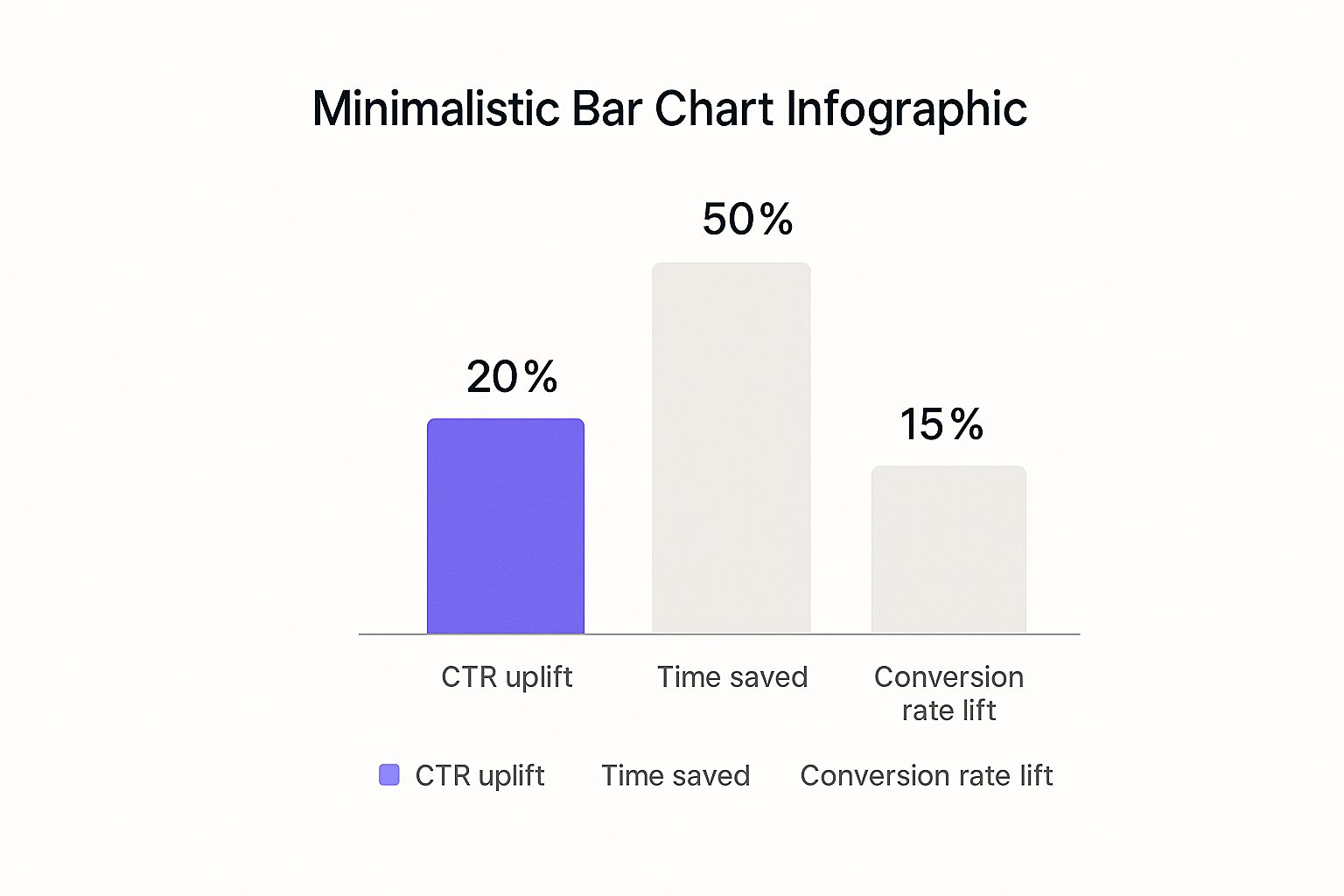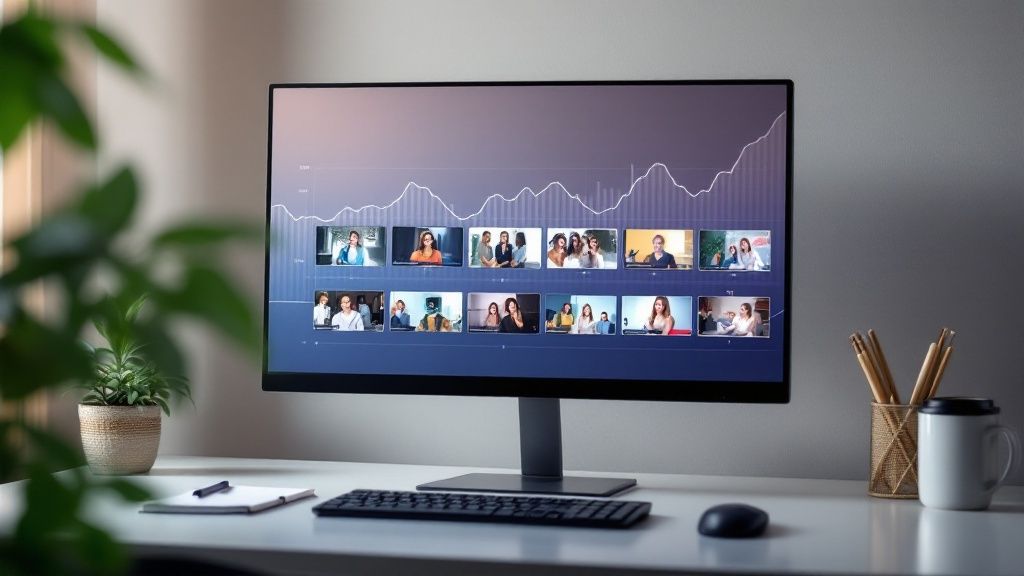The Evolution of Creative Testing: From Guesswork to Automation
Historically, creative testing relied on intuition. Marketers developed campaigns based on perceived audience understanding and hoped for the best. This approach was often inefficient, costly, and yielded unpredictable results. But the arrival of automated creative testing has changed everything. Marketing teams can now make data-driven decisions, minimizing risk and maximizing impact.
Data-Driven Decision Making
Automated creative testing uses AI and machine learning (Learn more about AI-powered creative testing) to analyze creative elements and predict performance across platforms and demographics. AI can assess headlines, visuals, and calls to action before launch. This predictive capability optimizes creative for maximum impact, reducing reliance on guesswork.
The adoption of AI in creative testing has transformed advertising by providing faster, data-driven insights. Predicting ad performance before release is crucial for channels like Connected TV, where cost and effectiveness are paramount. This allows for early refinement of creative concepts, saving time and budget. AI can deliver feedback in minutes, not weeks, enabling quicker decisions and multiple concept tests without delaying timelines. This shift from manual A/B testing to sophisticated prediction models empowers confident, data-backed decisions.
Streamlining Workflows and Maximizing ROI
Automated creative testing isn't just about prediction; it's about streamlining workflows. Automating repetitive tasks like A/B testing variations frees up marketing teams to focus on strategic initiatives. This efficiency translates to significant cost savings and faster campaign launches. Consider exploring resources like Sprello for creative workflow management. Understanding broader strategies for test automation provides a solid foundation. For valuable insights, check out this guide on automation testing best practices.

Beyond Basic A/B Testing
The future of automated creative testing goes beyond basic A/B testing. Advanced platforms like Sprello allow for multivariate testing, enabling marketers to test multiple variations of different creative elements simultaneously. This granular analysis reveals how each element contributes to overall campaign performance. As AI and machine learning evolve, automated creative testing will become even more sophisticated, offering powerful tools for optimizing creative and achieving exceptional results.
The ROI Reality: Making The Business Case For Automation
Automated creative testing is no longer a futuristic concept; it's a powerful tool delivering tangible results. This translates to a healthier bottom line, making a compelling argument for investment. But how can you quantify these benefits and persuade stakeholders of its value? The answer lies in emphasizing measurable ROI metrics.
Quantifying The Benefits Of Automated Creative Testing
Marketing teams are experiencing substantial improvements in key areas like reduced production costs, faster campaign launches, and higher conversion rates. Automated testing allows for swift iteration and optimization of creative components, leading to drastically shorter production times and significant cost reductions. For instance, a company might discover that automated testing cuts the time spent on manual A/B testing by a staggering 50%, freeing up valuable resources for other important strategic initiatives.

This infographic illustrates the potential gains from automated creative testing, showcasing marked improvements in Click-Through Rate (CTR), time saved, and conversion rate lift. These enhancements underscore how automated creative testing can dramatically impact campaign effectiveness and overall efficiency. This compelling data highlights the potential for substantial returns across vital performance indicators.
Furthermore, automated creative testing boosts conversion rates by quickly pinpointing high-performing creative variations. This optimization process facilitates continuous improvement, ensuring campaigns consistently connect with target audiences and drive desired outcomes.
To further illustrate the advantages of automated creative testing, let's examine a comparison table:
Introducing a comparison of key metrics between automated and traditional creative testing approaches, demonstrating the quantifiable benefits of automation.
| Metric | Traditional Testing | Automated Testing | Improvement |
|---|---|---|---|
| Production Costs | High (Manual processes, extensive resources) | Low (Automated workflows, reduced resource needs) | Significant Cost Reduction (e.g., 50% or more) |
| Campaign Launch Time | Slow (Manual design iterations, lengthy approvals) | Fast (Rapid iterations, streamlined approvals) | Significant Time Savings (e.g., weeks to days) |
| Conversion Rate | Moderate (Limited A/B testing capacity) | High (Continuous optimization, data-driven insights) | Substantial Conversion Lift (e.g., double or triple-digit percentage increase) |
| A/B Testing Time | High (Manual setup, analysis, and reporting) | Low (Automated setup, real-time analysis, and reporting) | Significant Time Savings (e.g., 50% or more) |
As the table clearly shows, automated creative testing offers substantial improvements across various crucial metrics. The reduced costs, faster launch times, and higher conversion rates contribute to a compelling ROI, making a strong case for adopting this approach.
Overcoming Objections And Setting Realistic Expectations
Securing stakeholder buy-in is paramount. Address any concerns head-on by presenting a well-defined ROI framework, outlining anticipated performance gains based on relevant industry benchmarks and internal data. While precise statistics on automated creative testing are still developing, the overall adoption of AI in marketing is quite revealing. For example, 45% of marketers employ AI tools like Jasper to brainstorm content concepts and ideas, and 43% utilize AI to automate repetitive tasks and processes. These trends highlight a growing dependence on AI for creative and strategic choices, suggesting that automated creative testing is poised for similar expansion. Discover more detailed statistics here.
Measuring Success And Demonstrating Value
Establish clear metrics aligned with campaign goals. Track key performance indicators (KPIs) like CTR, conversion rates, and CPA. Platforms like Sprello offer comprehensive analytics dashboards that deliver real-time insights into creative performance. This data-driven strategy enables you to showcase the tangible impact of automated creative testing to leadership, justifying ongoing investment and demonstrating its undeniable value to the company. This fosters continuous improvement and reinforces the critical role of data-driven creative decisions.
Building Your Testing Arsenal: Essential Components That Work

What sets a truly powerful automated creative testing platform apart from a simple analytics dashboard? It’s the core components working behind the scenes to provide a complete picture of creative performance. This empowers marketers to make informed, data-driven choices that boost campaign success.
The Power of AI and Machine Learning
At the center of any high-performing automated creative testing system is the dynamic duo of AI and Machine Learning. These technologies sift through massive datasets, uncovering hidden patterns and forecasting the potential of different creative variations.
This predictive capability allows marketers to optimize their creative before it goes live, saving precious time and resources. AI also analyzes a broader spectrum of variables than traditional methods, providing deeper insights into audience behavior. For a practical application, consider how AI is revolutionizing video content creation. Explore our guide on how to master UGC videos with AI influencers.
Seamless Data Integration
Top-tier automated creative testing platforms demand seamless data integration. This involves connecting with various data sources like ad platforms such as Facebook Ads Manager, CRM systems like Salesforce, and analytics dashboards like Google Analytics.
By centralizing data from these diverse sources, these platforms offer a holistic view of campaign performance, enabling a more precise evaluation of creative effectiveness. Marketers gain a comprehensive understanding of how their creative performs across multiple channels and touchpoints.
Balancing Quantitative and Qualitative Insights
While quantitative metrics like click-through rates (CTR) and conversion rates are crucial, truly effective automated creative testing goes further. It incorporates qualitative insights like brand perception and emotional resonance.
Grasping how creative connects with audiences on an emotional level allows marketers to craft more persuasive and impactful campaigns. This blend of data analysis and human understanding leads to more effective creative decisions. Understanding the return on investment (ROI) is paramount. For a deeper dive into this crucial aspect, consult this comprehensive guide on Marketing ROI Meaning.
The Human Element in Creative Decision-Making
Even with the most sophisticated automated testing tools, the human element remains indispensable. While AI provides valuable data and predictions, human creativity and intuition are still essential for crafting truly innovative and resonant campaigns.
The best platforms empower creative teams with data-driven insights to inform their decisions, not replace their expertise. This synergy between human ingenuity and machine intelligence unlocks the full power of automated creative testing.
The rise of AI in marketing and testing parallels the broader automation trend in software development. The global test automation market, valued at $15.87 billion in 2019, is projected to reach $49.9 billion by 2025. This growth reflects increased investment in automation, likely influencing AI adoption in creative testing. Find more detailed statistics here.
From Theory to Practice: Implementing Automated Testing
Unlocking the true power of automated creative testing demands a strategic, structured approach. This section offers a practical roadmap for seamlessly integrating automated testing into your existing marketing workflows. We'll guide you through every step, from initial setup and team training to ongoing performance monitoring, ensuring you're equipped to harness the full potential of this game-changing technology.
Step-By-Step Implementation Guide
Successfully integrating automated creative testing hinges on a series of key steps, each designed to maximize efficiency and impact:
Assessment: Start by thoroughly evaluating your current creative testing processes. Pinpoint bottlenecks and time-consuming tasks. This assessment forms the foundation of your automation strategy, allowing you to target areas ripe for improvement.
Tool Selection: Choose an automated creative testing platform that aligns perfectly with your specific needs and budget. Consider crucial factors like AI capabilities, data integration options, and robust reporting features. Sprello offers powerful solutions for managing and optimizing video content creation, streamlining your workflow and boosting efficiency.
Team Training: Empower your team with the knowledge and skills to master the chosen platform. Comprehensive training on test setup, result analysis, and data-driven insight implementation is crucial for maximizing the platform's potential.
Pilot Projects: Begin with small, targeted pilot projects to thoroughly test the platform and refine your processes. This controlled experimentation minimizes risk and allows for iterative improvement, paving the way for larger-scale implementation.
Scaling and Expansion: After achieving success with your pilot projects, gradually scale automated testing across your campaigns. Expand the scope and complexity of your tests as your team's expertise grows, ensuring continued improvement and optimization.
Overcoming Common Obstacles
The introduction of any new technology can present challenges. Here's how to proactively address common hurdles and ensure a smooth transition:
Creative Team Resistance: Alleviate concerns by emphasizing that automated testing empowers, not replaces, human creativity. The data-driven insights gleaned from testing provide invaluable guidance, enabling creative teams to make more informed decisions and achieve even greater impact.
Data Silos: Seamless data integration between your testing platform and other marketing tools is paramount. This integration breaks down data silos and provides a holistic view of campaign performance, enabling more informed decision-making.
Workflow Disruptions: Carefully integrate automated testing into existing workflows to minimize disruptions. Clearly defined roles and responsibilities ensure smooth collaboration between teams, maximizing efficiency and minimizing friction.
Establishing Clear Testing Protocols and Metrics
Well-defined testing protocols are essential for guiding your automated testing efforts and ensuring meaningful results:
Setting Clear Objectives: Define your goals upfront for each test. Are you aiming for increased click-through rates, higher conversion rates, or something else entirely? Clear objectives ensure focused and effective testing.
Identifying Key Metrics: Select the metrics that best align with your objectives. Track these metrics closely to accurately measure the impact of your tests and identify areas for improvement.
Creating Feedback Loops: Establish productive feedback loops between your creative and analytics teams. Sharing insights and learnings facilitates continuous improvement of your creative strategies and maximizes overall campaign performance.
Documenting Insights and Building Organizational Knowledge
Documenting the insights gained from automated creative testing is essential for building a valuable repository of organizational knowledge. Create a central hub for storing test results, analysis, and best practices. This shared knowledge base empowers your team to learn from past experiences, continuously refine their testing strategies, and drive ongoing improvement. As platforms like Meta explore automated creative variations for Reels, highlighted by Social Media Today and Mega Digital, the importance of data-driven creative decision-making becomes even more apparent. This evolving landscape underscores the need for a robust and structured approach to automated creative testing, ensuring you stay ahead of the curve and maximize your campaign impact.
Beyond Basic Testing: Advanced Optimization Strategies

Stop settling for average results. Moving beyond the basics of A/B testing unlocks a treasure trove of advanced optimization strategies, techniques that leading brands are already using to amplify the impact of their creative content. This shift involves embracing sophisticated testing methodologies and prioritizing sustained brand growth over fleeting short-term wins. Are you ready to join the ranks of the elite?
Multivariate Testing and Sequential Testing
Multivariate testing surpasses the limitations of A/B testing by empowering marketers to test multiple variations of numerous creative elements concurrently. This approach pinpoints the perfect combination of elements for maximum impact. Imagine evaluating different headlines, visuals, and calls to action all at once.
Multivariate testing provides a deep understanding of how these elements interact and influence overall performance.
Furthermore, sequential testing frameworks enable dynamic adjustments to testing parameters based on real-time data. This adaptable nature leads to more efficient resource allocation and faster identification of winning creative variations.
Balancing Short-Term Gains and Long-Term Brand Building
While short-term metrics like click-through rates (CTR) are essential, they shouldn't eclipse the long-term goal of building a powerful brand. Automated creative testing offers invaluable data that can shape broader creative direction and brand positioning.
This data-driven approach influences not only individual campaigns but also the entire brand narrative.
For example, analyzing audience reactions to different messaging themes can refine a brand's core message and solidify its identity. Want to learn more about leveraging AI for brand building? Check out this resource: How to master expressive AI influencer videos.
Advanced Techniques for Creative Optimization
Forward-thinking marketers are using automated insights to make tactical adjustments and steer their overall creative strategy. Controlling audience variables, like demographics and interests, allows for more focused and impactful testing.
For instance, a brand might test different messaging on specific age groups to determine what resonates most effectively with each segment.
Cross-channel testing ensures consistent messaging and branding across various platforms, creating a more cohesive and unified customer experience. Additionally, predictive analytics tools, like Google Analytics, help anticipate creative fatigue before it hinders performance. By analyzing historical data, these tools predict when a creative asset is likely to decline in effectiveness, allowing marketers to proactively refresh their campaigns.
To understand the impact of creative elements, let's examine the following table:
Creative Elements Impact on Performance Metrics
Statistical analysis of how various creative elements affect key performance indicators
| Creative Element | Impact on CTR | Impact on Conversion | Impact on Brand Recall |
|---|---|---|---|
| High-quality Images | Increased | Increased | Increased |
| Compelling Headlines | Increased | Increased | Moderate Increase |
| Clear Call to Action | Increased | Increased | Minimal Impact |
| Targeted Messaging | Significant Increase | Significant Increase | Moderate Increase |
The table above clearly demonstrates how different creative elements can influence various performance metrics. By strategically optimizing these elements, marketers can achieve significant improvements in CTR, conversions, and brand recall.
Adaptable Strategies for Different Campaign Objectives
Different campaign objectives demand distinct optimization strategies. Automated creative testing provides the adaptability to align with various goals. For example, awareness campaigns might prioritize metrics like reach and impressions, while conversion-focused campaigns emphasize click-through rates and sales.
Automated testing can be tailored to these specific objectives, delivering insights directly relevant to each campaign's goals. Meta is actively exploring automated creative variations for platforms like Reels, highlighting the increasing importance of data-driven decisions in the dynamic social media landscape. This allows marketers to stay agile and thrive in the ever-changing world of online advertising.
The Future of Creative Testing: Tomorrow's Opportunities Today
Automated creative testing is constantly evolving, changing how we evaluate and optimize marketing assets. New technologies are transforming the testing environment, offering exciting new potential for marketers who think ahead. These advancements will refine creative development, resulting in more effective and impactful campaigns.
Computer Vision and Emotional Response Prediction
Advanced computer vision analyzes visual elements in incredible detail. This technology goes beyond simply recognizing objects. It assesses composition, color palettes, and other visual cues to predict audience engagement. Imagine software understanding how a product's placement within an image affects viewer attention.
This insightful analysis provides marketers with data-driven recommendations for optimizing visual content, leading to higher engagement and conversion rates. Don't just guess – know what resonates with your target audience.
Predicting Emotional Responses
Emerging technologies are also exploring emotional response prediction. By analyzing facial expressions and other physiological indicators, these tools aim to gauge how creative evokes specific emotions. This provides invaluable data for crafting impactful campaigns.
This understanding allows marketers to tailor content to elicit desired responses and build deeper connections with their audience. Tap into the power of emotion to create truly resonant campaigns.
Generative AI and Continuous Optimization
Developments in generative AI are changing the relationship between testing and production. Imagine a system that not only tests existing creative but also generates new variations in real-time, constantly optimizing for peak performance.
This continuous optimization loop represents a significant shift from traditional testing methods, where optimization occurred in distinct phases. This new approach allows for constant adaptation and refinement, ensuring campaigns remain relevant and impactful in a dynamic market. Stay ahead of the curve with constantly evolving, high-performing creative.
Real-World Applications of Generative AI
This approach is already making waves. Meta is experimenting with automated creative variations for Reels, automatically generating different captions and covers to identify top performers. These experiments, highlighted by Social Media Today and Mega Digital, show a future where AI optimizes short-form video content. This automated process saves marketers time and resources while maximizing impact. Get ready for a future of streamlined and efficient creative optimization.
The Evolving Relationship Between Human Creativity and Machine Intelligence
The rise of automated creative testing raises important questions about human creativity and machine intelligence. While AI offers powerful analytical capabilities, human intuition and artistic vision remain essential. The key is finding the right balance.
The most effective approach involves a synergistic partnership. AI provides data-driven insights, while human creatives use this information to make informed decisions, ensuring marketing remains both effective and emotionally resonant. This collaboration creates campaigns that deeply connect with audiences.
Ethical Considerations
This powerful partnership also presents ethical considerations. As AI takes on larger roles in the creative process, it's crucial to address potential biases and ensure these technologies are applied fairly. Responsible implementation is key to harnessing the full potential of AI in creative testing.
Navigating Privacy Regulations and Cookie Deprecation
Privacy regulations and the deprecation of cookies are changing the digital advertising landscape, impacting how brands conduct creative testing. These changes limit user data, challenging traditional testing methods. However, these challenges also present opportunities for innovation.
Proactive brands are adapting by focusing on contextual advertising and first-party data strategies. These approaches prioritize user privacy while still allowing for effective creative testing. Contextual advertising, for instance, targets ads based on webpage content, ensuring relevance without relying on personally identifiable information. Stay ahead of the curve by embracing privacy-focused solutions.
Adapting to the Changing Landscape
By embracing these evolving methodologies, brands can optimize creative in a privacy-conscious way. This adaptability is crucial for success in the changing digital environment. The future of creative testing demands solutions that prioritize both performance and user privacy. Are you ready to adapt?
Ready to transform your creative testing? Sprello's AI-powered platform automates video creation and optimization. Learn more and start creating high-performing video ads today.



